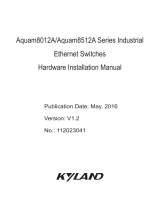
12
Installation BAT-R
Release
17
12/2020
Requirements for connecting the supply voltage
The following requirements apply without restrictions:
All variants All of the following requirements are complied with:
The supply voltage corresponds to the voltage specified on the type
plate of the device.
The power supply conforms to overvoltage category I or II.
The power supply has an easily accessible disconnecting device (for
example a switch or a plug). This disconnecting device is clearly
identified. So in the case of an emergency, it is clear which
disconnecting device belongs to which power supply cable.
The cross-section of the ground conductor is the same size as or
bigger than the cross-section of the power supply cables.
Only for device
variants featuring
supply voltage with
characteristic
value C (24 V DC ...
48 V DC) or W
(24 V DC):
The wire diameter of the power supply cable is at least 1 mm² (North
America: AWG16) on the supply voltage input.
The following requirements are alternatively complied with:
Alternative 1 The power supply complies with the requirements
for a limited power source (LPS) according to IEC/
EN 60950-1 or PS2 according to IEC/EN 62368-1.
Alternative 2 Relevant for North America:
The power supply complies with the requirements
according to NEC Class 2.
Alternative 3 All of the following requirements are complied with:
The power supply complies with the
requirements for a safety extra-low voltage
(SELV) according to IEC 60950-1 or ES1
according to IEC/EN 62368-1.
A back-up fuse suitable for DC voltage is
located in the plus conductor of the power
supply.
The minus conductor is on ground potential.
Otherwise, a back-up fuse is also located in the
minus conductor.
Regarding the properties of this back-up fuse:
See “General technical data” on page 58.
Only for device
variants featuring
supply voltage with
characteristic
value K (60 V DC ...
250 V DC /
110 V AC ...
230 V AC, 50 Hz ...
60 Hz):
All of the following requirements are complied with:
Supply with DC voltage:
A back-up fuse suitable for DC voltage is located in the plus conductor
of the power supply.
The minus conductor is on ground potential. Otherwise, a back-up
fuse is also located in the minus conductor.
Regarding the properties of this back-up fuse:
See “General technical data” on page 58.
The wire diameter of the power supply cable is at least 1 mm² (North
America: AWG16) on the supply voltage input.
Supply with AC voltage:
A fuse is located in the outer conductor of the power supply.
The neutral conductor is on ground potential at both voltage inputs.
Otherwise, a fuse is also located in the neutral conductor.
Regarding the properties of this fuse:
See “General technical data” on page 58.
The wire diameter of the power supply cable is at least 0.75 mm²
(North America: AWG18) on the supply voltage input.
Table 2: Requirements for connecting the supply voltage




















